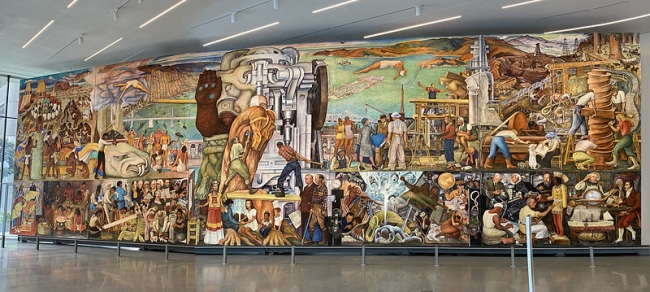You have /5 articles left.
Sign up for a free account or log in.

The “Pan American Unity” mural by artist Diego Rivera has been on display at the San Francisco Museum of Modern Art while on loan from City College of San Francisco.
Rob Corder/Flickr
City College of San Francisco and the San Francisco Museum of Modern Art are locked in a legal battle over a mural the college loaned to the museum. Both claim the other institution is responsible for the costs of returning the massive fresco to its original home. The mural, “Pan American Unity,” by the renowned Mexican painter Diego Rivera, stands 22 feet by 74 feet and weighs at least 42,000 pounds.
The museum filed a lawsuit against the college in San Francisco Superior Court in October, and the college fired back with a countersuit this month, both alleging the other is shirking their financial obligations laid out in an earlier loan agreement.
“The museum firmly disagrees with the assertions and claims made by CCSF in their legal complaint and public statement,” Clara Hatcher Baruth, the museum’s director of communications, said in an email. “SFMOMA has acted in accordance with the terms of the parties’ agreement and intends to continue doing so until this dispute is resolved.”
She added that museum officials are “gratified to share Pan American Unity in its free and accessible Roberts Family Gallery, where it has been viewed by over half a million people to date, and proud to have led a meaningful collaboration that included the conservation and study of this priceless work of art. SFMOMA is committed to working with CCSF to resolve this dispute and ensure the safe return of the mural in early 2024.”
Alan Wong, president of the CCSF Board of Trustees, said the college is “the rightful home of ‘Pan American Unity’” and the museum was supposed to set aside funds for its safe return.
The college is “where this great piece of art belongs, and we want to continue to be able to share it with the world, so it’s really disappointing that SFMOMA decided to have this lawsuit instead of trying to work with us to resolve this,” he said.
City College of San Francisco previously housed the mural in its Diego Rivera Theater until the facility needed to be rebuilt, according to the lawsuit filed by the museum. To keep the artwork safe, the college loaned the mural to SFMOMA in 2021, where it was restored and displayed to the public, with the expectation it would be returned to campus this academic year.
Museum officials contend that the college agreed to cover any costs associated with the art that exceeded an agreed-upon cap of $3.975 million in a 2019 loan agreement. The museum has spent at least $4 million. Given the size and fragility of the artwork, “neither party knew whether or how it could be done or how much it would cost, and both parties understood that known and unknown factors could complicate or increase the cost of the project,” their lawsuit claims. They also argue that plans signed by the then chancellor in 2020 showed that the museum was likely going to need to spend more than that amount.
“As early as Fall 2022—and on multiple other occasions—SFMOMA alerted CCSF that SFMOMA would exceed, and then had exceeded, the cap on its financial obligations and that CCSF would therefore have to bear all remaining project costs as the Agreement requires,” the museum’s lawsuit states.
The lawsuit also notes that the college received $181.3 million in San Francisco taxpayer bonds to partially pay for the theater reconstruction and argues a portion of that money should go toward transporting the mural back to the campus. It asserts that the mural now risks taking up space intended for other exhibits in 2024.
“SFMOMA stands ready and willing to return the Mural to CCSF’s campus: The only obstacles are CCSF’s repudiation of its obligation to pay the associated costs and its refusal to participate in time-sensitive and necessary planning for the return transit of the Mural,” the lawsuit reads.
College officials say in their response complaint that $1 million of the $3.975 million budget was supposed to be reserved for the return of the mural, according to a budget estimate in the agreement. They also note that the agreement stipulates that SFMOMA can cancel the agreement “if it determines it cannot complete the Project within the budget,” yet SFMOMA didn’t cancel.
“With respect to SFMOMA’s expenditure of funds, there are many unanswered questions. It is unclear to CCSF why the funds were expended in a manner that resulted in SFMOMA exceeding its budget and not having funds available [to] complete the Project,” Constance Schwindt, an attorney representing the college, wrote in a May letter to the general counsel for SFMOMA.
The letter also contests a claim from SFMOMA officials that the return date had been officially postponed from September 2023 to early 2024.
College leaders further claim the bonds referenced in SFMOMA’s lawsuit can only be used for the construction of campus facilities.
“The budget to take care of and return the mural has been exceeded, and now we’re being asked to use our school bond dollars meant for our college facilities and buildings to pay for it,” said Wong, the college’s board president. “Whether it be our bond dollars or our district’s discretionary budget, these are taxpayer dollars that we’re talking about. And we have to be transparent and accountable to the public on how we spend it.”
Sergio Muñoz Sarmiento, an arts lawyer, said from what he can tell from the dueling complaints, museum and college leaders seem to be “disagreeing on the meaning of different sections in the agreement,” such as the precise meaning of the term “budget cap” and the expenses that were to be included within it. He said he could imagine this situation as a case study in a contract law class at his alma mater, Cornell University, and a professor asking, “How could this have been avoided? How could these clauses have been clarified?”
“One thing that struck me in this matter is how important the drafting of an agreement is, how important the language is to an agreement,” said Sarmiento, who also founded the Art and Law Program, a seminar focused on visual culture and law mostly attended by artists. He said he tells his clients to spend extra time drafting and negotiating a carefully worded contract to avoid future lawsuits and expensive attorneys’ fees.
The dispute comes at a time when the museum is struggling financially. Chris Bedford, its director, said in an open letter to museum goers earlier this month that museum attendance is only at 65 percent of what it was pre-pandemic, and as a result, the museum has laid off seven staff members and decided to leave 13 open positions unfilled.
“The decision to lay off staff is tremendously difficult and one we actively worked to avoid,” Bedford wrote.
CCSF has also had its share of financial struggles in the last decade, though its finances have stabilized for now. After years of deficits and a controversial rash of layoffs in 2022, the college is no longer in debt and received its first independent audit with no negative findings in 25 years, Wong said.
However, the college’s financial problems aren’t necessarily over. CCSF got a substantial amount of additional money from the state this year as “hold harmless” funding, intended to ease the transition to a new funding formula for some college districts. But the funding ends next year. Wong proposed a policy last year that requires college officials to develop a multiyear budget plan and give monthly reports to the board because of his worries for the college’s financial future.
“I am very concerned about how we meet those challenges,” Wong said. “We need every dollar that we have for our school resources, for our school buildings and for our classrooms right now.”








